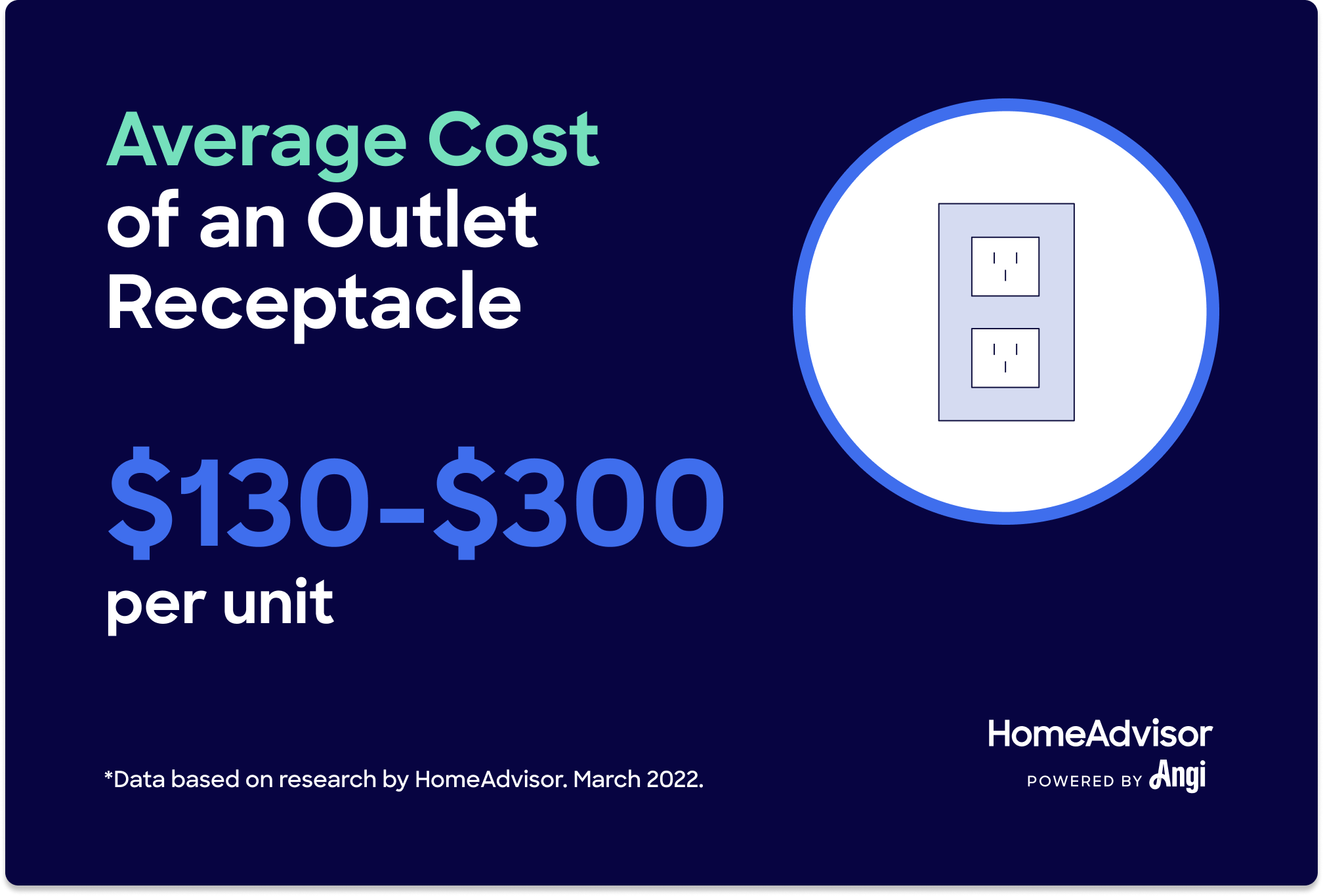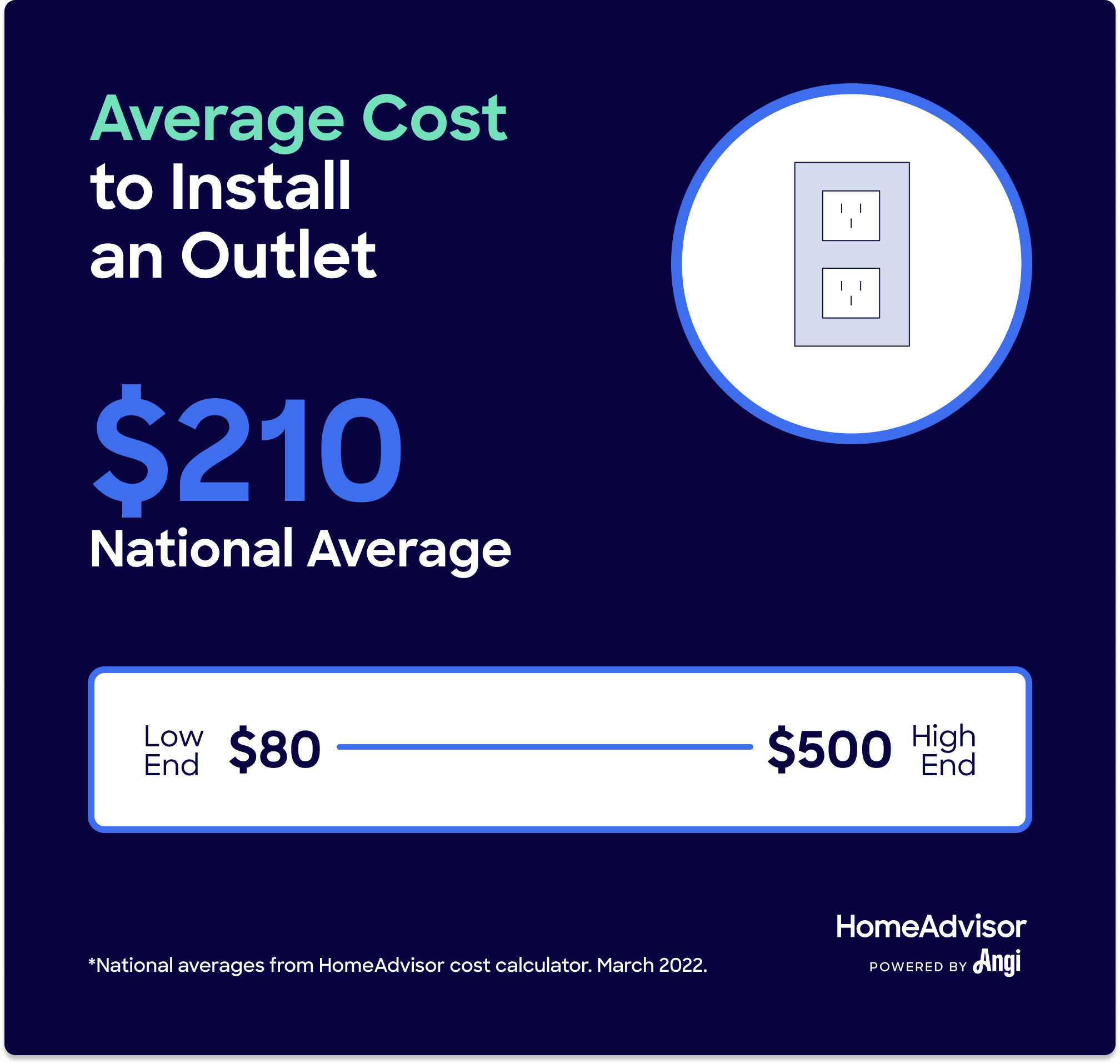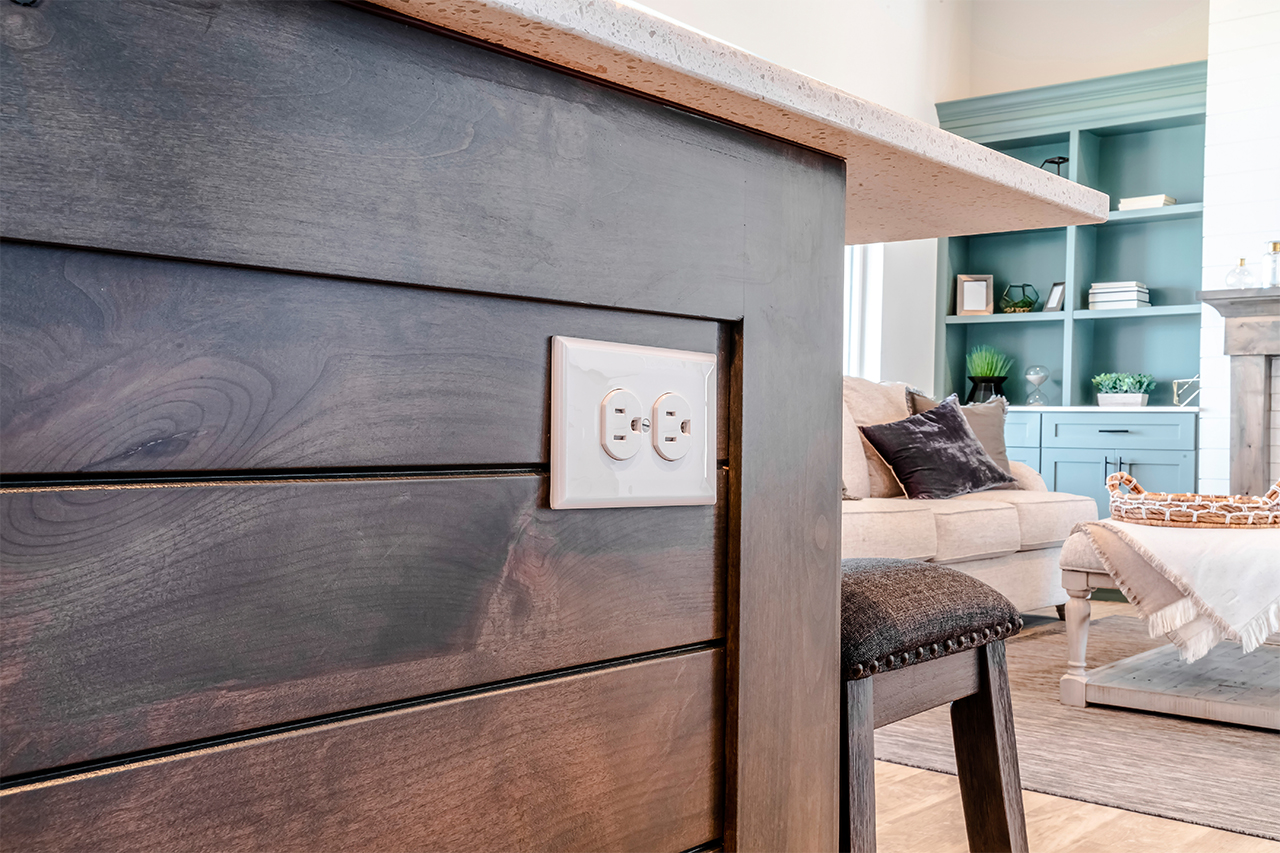How Much Does It Cost to Install Electrical Outlets?
Typical Range:
$137 - $319
Typical Range:
$137 - $319
Cost data is based on actual project costs as reported by 4,632 HomeAdvisor members. Embed this data
.
.
.
.
.
.
.
.
.
.
.
.
.
.
.
.
.
.
.
.
.
.
.
.
.
.
.
.
.
.
•
•
•
•
Updated April 18, 2022
Reviewed by Salvatore Cutrona, Angi Expert Review Board member and founder of Cutrona Electric, LLC, in Sherman, CTThe cost to install an electrical outlet averages $215. A new one can cost as little as $75 or as much as $485. The project typically ranges from $134 and $298.
Each receptacle unit will cost between $3 and $50 depending on the type you need. The price of hiring an electrician will range from $40 to $100 per hour depending on the pro you choose. Some, such as GFCI-protected or 220-volt units, will cost more in both materials and labor to install than others, like a standard, 120-volt unit.
Let's calculate cost data for you. Where are you located?
Where are you located?
| National Average | $228 |
| Typical Range | $137 - $319 |
| Low End - High End | $80 - $596 |
Cost data is based on actual project costs as reported by 4,632 HomeAdvisor members.
The biggest factor in the price to install an electrical outlet is the type you choose, which will range from $3 to $50. Most electricians include this cost in the total project quote. If a homeowner already has materials or requires a specialty unit, an electrician will charge for installation only.
Standard outlets of 120 volts are typically on the lower end of the spectrum at $3 to $5 each. These 15-amp units, in use since the 1950s, can also power 110-volt devices. The actual voltage ranges from 110-125 volts, and manufacturers build modern appliances to withstand the variations.
A standard 15-amp, 120V with two USB ports costs $13 to $22. Including USB ports in the socket allows you to plug smartphones, tablets, and other USB-powered devices directly into the wall to charge.
Standard units are available with either two prongs or three. Two-prong receptacles will be at the lower end of the standard price range of $3 to $5. Three-prong versions will be on the higher end.
A two-prong outlet has a "hot" and "neutral" line only. The hot line connects to the power, and the neutral line completes the circuit. Older homes often feature 2-prong outlets.
A three-prong unit also includes a "ground" wire that connects to the earth to drain unused power. In appliances with metal casing or metal power supplies, like microwaves and computers, the metal connects directly to the ground prong on the power cord. If there is a loose wire, grounded receptacles trip a circuit breaker to shut off dangerous power and prevent electric shock. Since 1968, homes have been required to feature three-prong outlets.
Standard, higher-voltage versions are also in the lower price range. In the past, electricians could offer both 220V and 240V outlets. Now, most come in at 250V.
Heavy appliances like electric clothes dryers and ovens typically require these higher-voltage units. Exact price will depend on the type of appliance and required amperage.
| Amperage | Outlet Type | Cost |
|---|---|---|
| 20 | Straight-blade, narrow body | $12 - $18 |
| 30 | Dryer | $10 - $12 |
| 30 | Surface-mount dryer | About $12 |
| 50 | Ranges | $10 - $20 |
Ground fault circuit interrupter (GFCI) receptacles for kitchens, bathrooms, or any area near water or moisture are typically a little bit more expensive at $7 to $25 each. Exact costs depend on quality and style, because all GFCI units function the same way.
Like a standard, 3-prong outlet, a GFCI receptacle has a ground wire. Both types of units feature two vertical slots and a round hole. The left, "neutral" slot on the unit is slightly larger than the right, "hot" slot. The hole is the "ground." When an appliance is working properly, all electricity generated flows from "hot" to "neutral."
Unlike a standard unit, this type monitors the amount of current flowing. An imbalance of as little as 4 milliamps will trip the circuit in as little as one-thirtieth of a second.
Average cost of a coaxial wall plate is about $5. A phone, television, or internet provider usually installs these, not an electrician.
Box kits run between $30 and $50 each. You may step on the receptacle or expose it to water when cleaning the floor. To ensure safety and durability, these require an approved assembly that consists of a:
metal box
gasket seal
special receptacle
durable cover plate
moisture-proof cover
Hardwired smart outlets range from $25 to $50 each. Some brands, like Amazon Echo and Google Home, need a separate control hub that connects the unit to the internet and/or allows voice activation. These can reduce electricity consumption and save money on electric bills.
Homeowners can buy plug-in smart models for $15 to $40 online or at big box and hardware stores. Standalone plugs, power strips, and switches offer many of the benefits of hardwired versions but can simply be inserted into existing units.
A professional electrician charges an average of $55 per hour, but labor rates can range from $40 to $100 per hour. A seasoned pro can replace up to a dozen in an hour, while installing a single new one can take up to two hours. Actual rates will depend on the type of installation and the pro's skill level.
Electricians generally charge by the receptacle for new homes or whole-home remodels instead of by the hour. The electrician will set a price for each receptacle based on labor and materials and multiply it by the total number of outlets in the home.
He or she will price installation of specialty items separately. The cost to install light fixtures and bathroom exhaust fans will include materials and labor. Price to install items provided by the homeowner will be labor only.
Installing in the floor or ceiling allows homeowners to access electricity from the middle of a room, preventing the need to run dangerous, unsightly cords from the wall. The hourly labor rate to install these receptacles will be the same.
However, there are some factors that could increase installation costs by increasing the amount of time it takes to install. For example, concrete floors and floors over finished ceilings may be more difficult to work with than those over unfinished basements or crawl spaces. Likewise, ceilings under floors will need more care than those below attics.
Certain locations in your home may require heavy-duty or GFCI units, which will cost slightly more to install due to the price of the unit itself and the necessary skill required. Refer to the GFCI section below for a list of areas requiring GFCI protection.
Heavy-duty, 250V outlets for dryers, refrigerators, air conditioners, ranges, and other appliances cost more to install than standard, 120V units. Specialty receptacles cost more up front and also take more time and expertise to install. For pricing on your specific project, consult a professional for a quote.
You will have to see if you need to install new wiring to accompany your new outlet, which will increase the price charged by an electrician. You will also need to ensure that the new unit won't draw too much power from one circuit. If it does, a new circuit is required. Your professional contractor can inspect the area and account for the additional added work needed in the project quote.
A common concern with electrical outlets is childproofing them for when kids will be present. This will be an added expense to the installation cost, but one that will increase safety and add to your peace of mind. The price to do this shouldn't tip the average rate of an electrician by much.
Tamper-resistant (TR) receptacles are about 50 cents more than traditional receptacles. TR units feature spring-loaded receptacle cover plates. When you apply equal pressure to both sides, the cover plates open. When you apply pressure to only one side, they remain closed, preventing children from inserting foreign objects. National code requires TR units in new construction.
Installing or replacing a GFCI outlet will cost about the same as putting in a standard receptacle, except for the price of the unit itself. However, electrical code requires outlets in areas of the home where water or moisture is present to be GFCI-protected. In some cases, the receptacle must run off a 20-amp circuit, which may also impact overall project cost.
| Room | Code Requirements | Potential Added Costs |
|---|---|---|
| Bathroom |
| Additional electrical panel amperage and GFCI receptacles |
| Kitchen |
| Additional electrical panel amperage and GFCI receptacles |
| Laundry Room |
| Additional electrical panel amperage and GFCI receptacles |
| Garage |
| Additional receptacles and GFCI receptacles |
Replacement and repair is usually straightforward for a licensed, experienced professional. However, factors like accessibility or the scope of work can increase the amount of time it takes to complete a project, which may impact project costs.
In some cases, a faulty outlet may indicate a bigger overall problem with your home's wiring. In this case, your small repair project may turn into a more involved, more expensive venture.
Rewiring: $540 to $2,100. Varies per project and hours needed.
Service Panel Replacement: $1,300 to $3,000 including materials, to upgrade to a 200-amp panel for enhanced electrical needs.
Opening walls and running wires: $3,500 to $8,000. Added cost to open and repair walls.
Open ground: consult a pro for a quote. May be a simple fix or may require extra hours of work to locate problem.
Upgrading can enhance safety and convenience for a homeowner. Expectant parents may consider upgrading to TR units. Owners of older homes may want to replace 2-prong receptacles with grounded, 3-prong units.
Technologically-inclined homeowners may want to incorporate smart models to manage their devices and save energy. In addition to cost considerations, you'll want to be sure you upgrade according to code.
Taking your standard 2-prong outlets into the 3-prong variety is a common project. If you have a grounded fuse box, a seasoned pro can replace the outlet in about half an hour for a total cost of $20 to $50. If your electrician must ground your fuse box or upgrade your panel, price of the project will increase. Before you change anything, you should consult a professional to determine your home's status and provide an exact quote.
This project can run as little as $25 or as much as $300. The type you choose will affect material costs. Condition of the walls will be the biggest cost factor when it comes to labor. Working on exposed walls without drywall or insulation takes less time and work for an electrician. Finished walls may require additional work and drywall repair, increasing the total project price. Consult your pro for an exact estimate.
If you need to install an outlet, you'll need to find a reputable, licensed electrician to do the work. Some smaller electrical jobs may seem doable on your own, but electrocution and fire are valid electrical safety hazards. A pro will also know the local codes and laws surrounding electrical work in your area. Making sure everything is up to code will save you headaches in the future and ensure your family is safe.
Electrical work and repair costs will depend on the electrician you choose. You can save some money by getting all of your electrical needs taken care of at once. Overall, putting in new outlets is an affordable job compared to other home projects.
One of the easiest ways to bring down the average rate of an electrician is to bundle a few electrical jobs at once since pros tend to charge by the hour. Determine if there are any other rooms that have been a hassle because of too few outlets and speak with your electrician before he or she arrives at your home.
If there are no electrical outlets for your television within reach, a new outlet can be installed. Most TVs require a standard outlet, which will run between $130 and $290 for materials and installation.
Most countertop and over-the-range microwaves require a 120V, three-prong outlet on a dedicated circuit. The cost of these outlets will be on the higher end of the typical 120V cost range at $3 to $5. You’ll also need to budget for labor, which averages about $55 per hour.
Stoves and ranges require higher voltage. In addition to a 240V, most electricians now offer a 250V, which is most suitable for stoves and ovens. The cost of a 240V outlet is $10 to $20, plus the cost of installation.
Most electricians charge an average of $55 per hour, but your price could be higher as specialty receptacles cost more up front and also take more time and expertise to install.
Light switches of various types average $5 to $15 each and $100 to $200 to install. Though it’s considered a quick process, you will still benefit from professional installation to ensure proper wiring.
The hourly rate for an electrician is $50 to $100 and homeowners can make the most of that rate by bundling other electrical jobs with the work.


